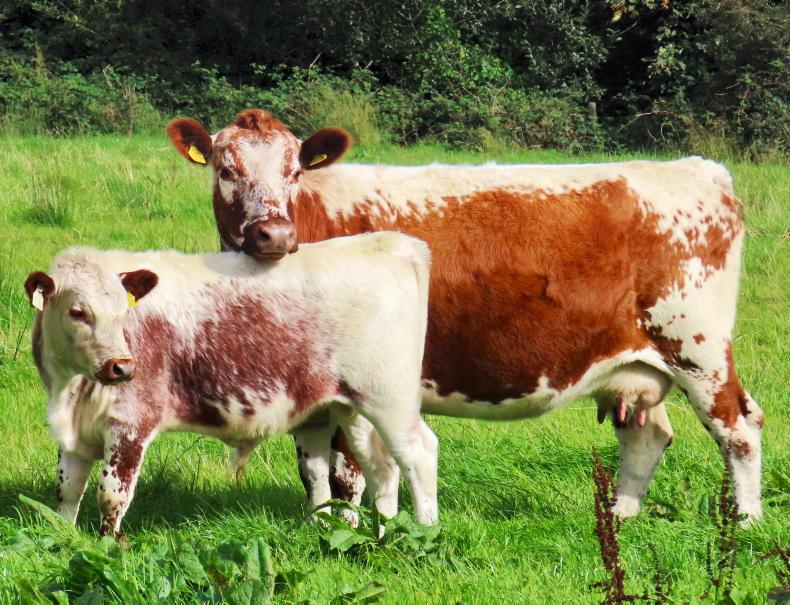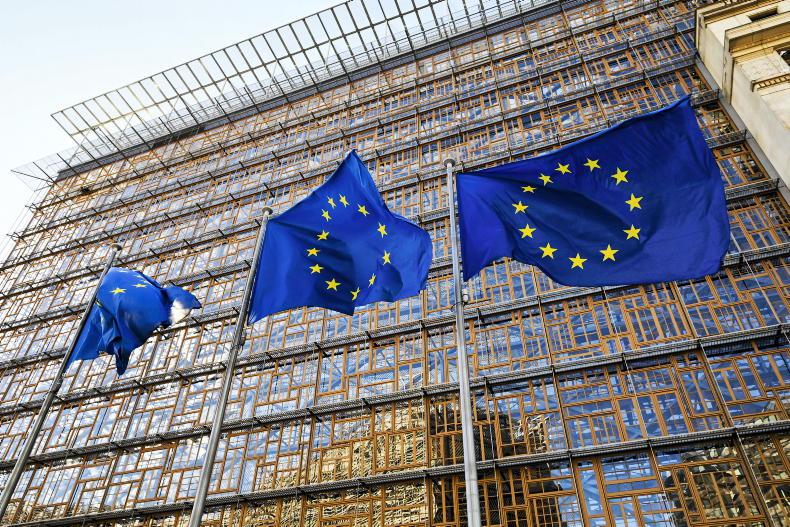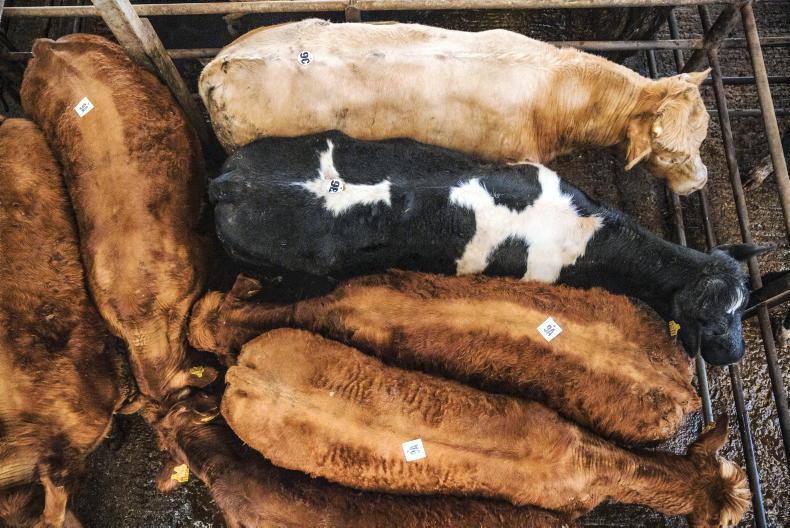In the coming weeks, most suckler farmers will need to be aware of some key actions and dates in relation to guaranteeing this year’s SCEP and National Beef Welfare Scheme payments.
Speaking to the Irish Farmers Journal at the FBD National Livestock Show in Tullamore last Sunday, Minister for Agriculture Charlie McConalogue ruled out any changes to the National Beef Welfare Scheme, citing the IBR testing inclusion as an important step in eradicating the disease in the future.
Some farmers have been holding off applying to the scheme with the thoughts that there may be changes before the 12 September closing date.
The biggest frustration has been around the IBR testing and the reduced payment rates in the 2023 scheme. Nonetheless, there is a potential €200/cow worth of support payments to come into a lot of small suckler herds in the next few months, so it’s important if you are in the schemes that you get them right to avoid any penalties.
Suckler Carbon Efficiency
Programme (SCEP) Reminders
Genotyping
ICBF hase selected animals to be genotyped in each herd and will notify herd owners of the animals selected. It is possible for herdowners to nominate animals for genotyping other than those selected by ICBF, but this needs to happen fast.
The number of animals to be genotyped each year will be at least equivalent to 70% of the beneficiary’s “yearly reference number” (rounded down to the nearest animal).
For example, an applicant with a yearly reference of 10 must have sufficient animals to genotype 7 females, calves or eligible bulls, without repetition of animals genotyped under the programme to date.
Tags were posted out to scheme applicants in mid-summer for Year 1 of the scheme. Tags will be sent out in early spring in future years. Samples must be returned by 30 November this year.
Weighing
Participants must weigh at least 80% of eligible animals born on the holding of the yearly reference number in each scheme year and their dams and submit weights to ICBF.
Each live calf must be unweaned and weighed with its dam on the applicant’s holding on the same day. Where a calf dies before five months of age or its dam, this must be recorded on AIM and the 80% does not include such pairs.
All calves being submitted for weighing must have been born in the herd within each scheme year.
The calf must be a minimum of 50 days old before it is eligible to be weighed. Weights should be submitted within seven days of weighing and no later than 1 November annually.
Female replacement strategy
Applicants are required to ensure that by 31 October 2023 at least 50% of their yearly reference number are eligible females that are genotyped four or five stars on the replacement index (on a within breed or across breed basis) at the time of purchase (for replacements brought into the herd) or at the time of genotyping (for those replacements bred within the herd).
This target increases to 65% by 31 October 2025 and 75% by the 31 October 2027. Genotyped females must be at least 16 months old on these dates.
For new entrants to SCEP in 2023, it is really important to get your animals genotyped as soon as possible to make sure you know where you stand for the 31 October deadline.
Quality Assurance compliance
Participants in SCEP must be an approved member of the Bord Bia Sustainable Beef and Lamb quality assurance scheme by 16 October 2023.
Bord Bia had been advising farmers to leave a two month window from the time of application to approval in case of any issues along the approval process.
There are just over 1,500 farmers that are still not QA approved. The Department of Agriculture will be cross referencing the participation in the QA scheme on 16 October to ensure compliance with the scheme. Any farmer not in QA by this date will be ineligible for the SCEP scheme.
Meal feeding
The meal feeding option in the National Beef Welfare Scheme (NBWS) is a pretty simple one, but it’s important to get the dates right. It’s important that key actions are completed within the required time-frame, which is in the next few weeks.
This will include feeding concentrates and weaning prior to selling the weanlings. Meal feeding needs to commence four weeks prior to weaning and continue for two weeks after weaning. Meal feeding is to ease the weaning process and reduce stress levels around weaning time and try to minimise any outbreaks of disease like pneumonia.
It will also mean calves should have better weight gains if being offered creep feed. With suckler weanlings you are probably talking about a conversion ratio of 6:1 or 7:1 depending on breed type and sex.
If top end weanlings are hitting €3/kg then it pays to feed meal to weanlings. A kilogram of liveweight gain will cost €2.40-€2.80/kg to put on.
Table 1 outlines some example dates and timelines in order to be compliant with the scheme. The Department of Agriculture does not require notification of meal feeding, however, if you have an inspection you will be asked to provide meal dockets to show proof of purchase of meal during the required time.
IBR testing
There has been a huge reaction to the inclusion of the IBR testing element of the programme. The Department of Agriculture has made it a little easier to opt out of IBR testing, lowering the penalty rate to 10%. Not completing the IBR testing on a 20 cow herd would mean a fine of €400 on a possible payment of €1,000.
In the coming weeks, most suckler farmers will need to be aware of some key actions and dates in relation to guaranteeing this year’s SCEP and National Beef Welfare Scheme payments.
Speaking to the Irish Farmers Journal at the FBD National Livestock Show in Tullamore last Sunday, Minister for Agriculture Charlie McConalogue ruled out any changes to the National Beef Welfare Scheme, citing the IBR testing inclusion as an important step in eradicating the disease in the future.
Some farmers have been holding off applying to the scheme with the thoughts that there may be changes before the 12 September closing date.
The biggest frustration has been around the IBR testing and the reduced payment rates in the 2023 scheme. Nonetheless, there is a potential €200/cow worth of support payments to come into a lot of small suckler herds in the next few months, so it’s important if you are in the schemes that you get them right to avoid any penalties.
Suckler Carbon Efficiency
Programme (SCEP) Reminders
Genotyping
ICBF hase selected animals to be genotyped in each herd and will notify herd owners of the animals selected. It is possible for herdowners to nominate animals for genotyping other than those selected by ICBF, but this needs to happen fast.
The number of animals to be genotyped each year will be at least equivalent to 70% of the beneficiary’s “yearly reference number” (rounded down to the nearest animal).
For example, an applicant with a yearly reference of 10 must have sufficient animals to genotype 7 females, calves or eligible bulls, without repetition of animals genotyped under the programme to date.
Tags were posted out to scheme applicants in mid-summer for Year 1 of the scheme. Tags will be sent out in early spring in future years. Samples must be returned by 30 November this year.
Weighing
Participants must weigh at least 80% of eligible animals born on the holding of the yearly reference number in each scheme year and their dams and submit weights to ICBF.
Each live calf must be unweaned and weighed with its dam on the applicant’s holding on the same day. Where a calf dies before five months of age or its dam, this must be recorded on AIM and the 80% does not include such pairs.
All calves being submitted for weighing must have been born in the herd within each scheme year.
The calf must be a minimum of 50 days old before it is eligible to be weighed. Weights should be submitted within seven days of weighing and no later than 1 November annually.
Female replacement strategy
Applicants are required to ensure that by 31 October 2023 at least 50% of their yearly reference number are eligible females that are genotyped four or five stars on the replacement index (on a within breed or across breed basis) at the time of purchase (for replacements brought into the herd) or at the time of genotyping (for those replacements bred within the herd).
This target increases to 65% by 31 October 2025 and 75% by the 31 October 2027. Genotyped females must be at least 16 months old on these dates.
For new entrants to SCEP in 2023, it is really important to get your animals genotyped as soon as possible to make sure you know where you stand for the 31 October deadline.
Quality Assurance compliance
Participants in SCEP must be an approved member of the Bord Bia Sustainable Beef and Lamb quality assurance scheme by 16 October 2023.
Bord Bia had been advising farmers to leave a two month window from the time of application to approval in case of any issues along the approval process.
There are just over 1,500 farmers that are still not QA approved. The Department of Agriculture will be cross referencing the participation in the QA scheme on 16 October to ensure compliance with the scheme. Any farmer not in QA by this date will be ineligible for the SCEP scheme.
Meal feeding
The meal feeding option in the National Beef Welfare Scheme (NBWS) is a pretty simple one, but it’s important to get the dates right. It’s important that key actions are completed within the required time-frame, which is in the next few weeks.
This will include feeding concentrates and weaning prior to selling the weanlings. Meal feeding needs to commence four weeks prior to weaning and continue for two weeks after weaning. Meal feeding is to ease the weaning process and reduce stress levels around weaning time and try to minimise any outbreaks of disease like pneumonia.
It will also mean calves should have better weight gains if being offered creep feed. With suckler weanlings you are probably talking about a conversion ratio of 6:1 or 7:1 depending on breed type and sex.
If top end weanlings are hitting €3/kg then it pays to feed meal to weanlings. A kilogram of liveweight gain will cost €2.40-€2.80/kg to put on.
Table 1 outlines some example dates and timelines in order to be compliant with the scheme. The Department of Agriculture does not require notification of meal feeding, however, if you have an inspection you will be asked to provide meal dockets to show proof of purchase of meal during the required time.
IBR testing
There has been a huge reaction to the inclusion of the IBR testing element of the programme. The Department of Agriculture has made it a little easier to opt out of IBR testing, lowering the penalty rate to 10%. Not completing the IBR testing on a 20 cow herd would mean a fine of €400 on a possible payment of €1,000.










SHARING OPTIONS